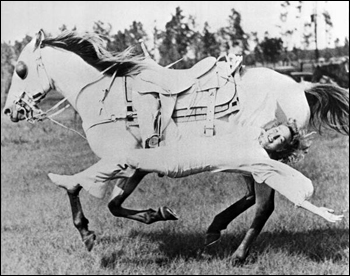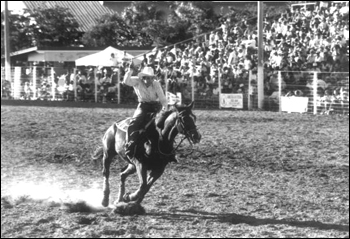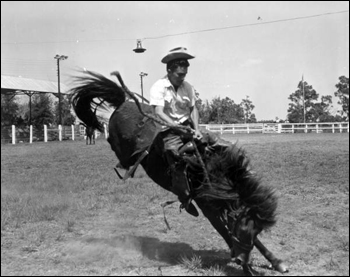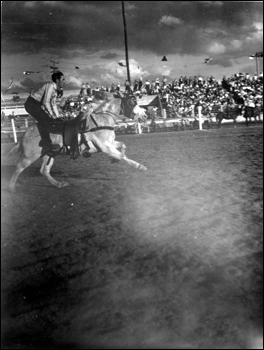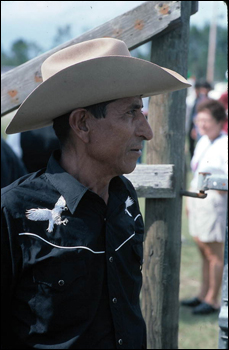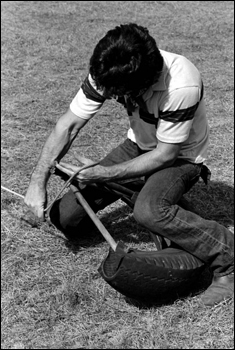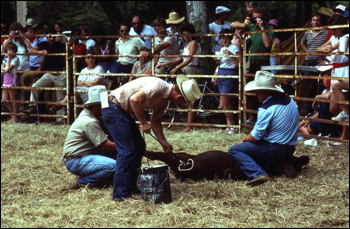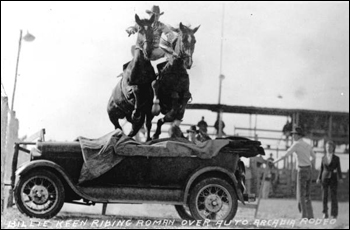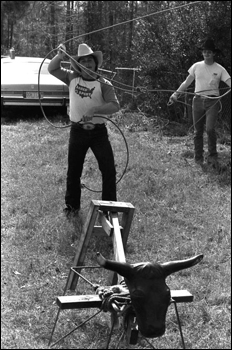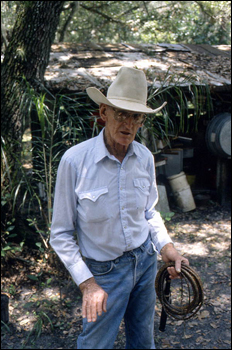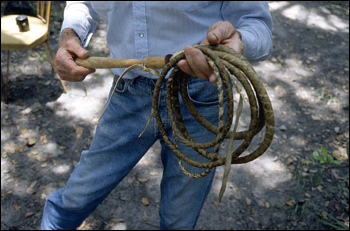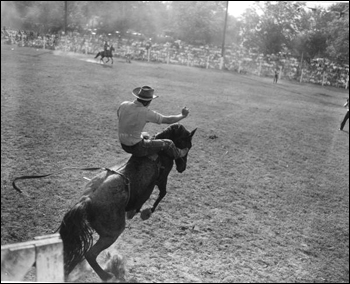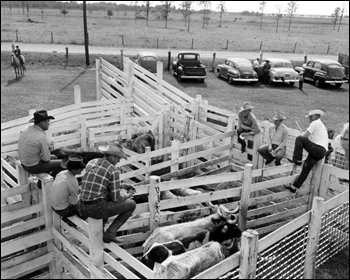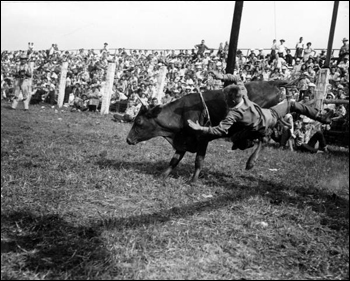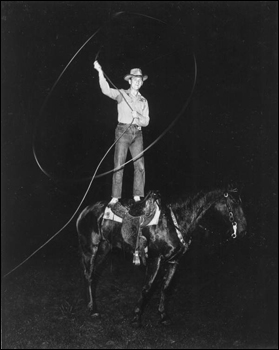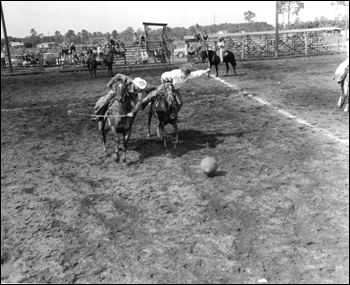Photo Exhibits
Photo exhibits spotlight various topics in Florida history, and are accompanied by brief text intended to place selected materials in historical context.
Florida Cattle Ranching
Sport and Artistry
Faye Blackstone executing a reverse fender drag (1952)
Image Number: N036758
Blackstone invented some riding tricks. She and her husband are both in the National Cowboy Hall of Fame.
Cowwoman throws out her lasso: Homestead, Florida
Image Number: C821861
Occupational Skills
The many occupational skills of the working cowboy are learned informally, through observation and imitation. In the past, roping cattle was not a common practice in Florida because of the extensive areas of dense scrub where a snagged rope could result in a serious accident. Since screw-worm treatment required that each animal be roped and subdued, cowmen adopted lariats and replaced hornless McClellan saddles with western-style saddles. Today, roping is a valuable occupational skill.
Traditional methods of cattle identification include flank branding with a hot iron and "marking" one or both ears using a knife to cut a combination of standardized shapes. It is common practice to mark and brand cattle because earmarks are often easier to read from a distance. One owner may have several different brands and earmarks, and individual family members often have their own brands and marks. Today, ranchers usually brand by applying an iron heated by a portable "pot" fueled by a small propane tank or by using an electrically heated branding iron. Some use numbered plastic ear tags rather than earmarks.
Good equestrian skills and a well-trained horse are essential to successful cattle tending and serve as important symbols of ranching culture. Ranch horses are trained for specific tasks, such as stock sorting and roping. Although the American Quarter Horse is used by cowboys throughout the U.S., some Floridians prefer the smaller Cracker Horse for its agility and stamina during hot weather.
Cowboy rides a wild horse at the Tupperware Jubilee: Orange County, Florida (1955)
Image Number: C021121
Bobby Boulter during the trick riding exhibit: Lakeland, Florida (1947)
Image Number: C002093
Portrait of accordionist Felix Soto, Mexican-American "Norteño" musician: Pierson, Florida (1995)
Image Number: FA6253
Man practicing for the rodeo with a calf tying jig: Macclenny, Florida (1984)
Image Number: FA0913
Cowboys branding a cow with paint: White Springs, Florida
Image Number: FS851385
Cow-Dogs
Florida is one of the leading states in the use of dogs for cattle ranching. Florida cow-dogs are mixed breeds. Probably the most popular breed in the mix is the Southern Blackmouth Yellow Cur. Another popular breed is the Catahoula Leopard, which may have its origins among the French or Native Americans of Louisiana.
Florida cow-dogs perform three important functions. The cow-dog flushes strays from hammocks, scrub, and swamps, working easily in areas that are difficult for horse and rider to penetrate. While mounted cowmen drive the cattle from the rear, cow-dogs control their movements by working the sides and front to keep the stock in a cohesive herd. And, since cattle view the dogs as predators, they will seek safety by gathering into a tight group when the cow-dogs repeatedly circle or "ring" them, while barking and nipping.
Billie Keen riding horses over an automobile: Arcadia, Florida (1930)
Image Number: RC11253
Nemo family performs a Russian cossack act: Lakeland, Florida (1950)
Image Number: C012629
Man practicing for the rodeo roping with a dummy: Macclenny, Florida (1984)
Image Number: FA0910
Image Number: FA2464
Okeechobee cowboy Mills painstakingly fashions whips from buckskin by first cutting the "strings" from tanned hides and then plaiting several layers in a carefully controlled taper. To achieve a smooth taper, he is exacting about the dimensions to which he cuts the strings and is careful to plait them under just the right amount of tension. The "belly," or thickest part of the whip, consists of four layers. At the end of the whip, he ties a thin piece of deerskin, about a foot long, called a "cracker." It is this component that is responsible for the loud noise. He protects his finished whips from sun, sand, rain and abrasion by coating them with a mixture he makes by heating beef tallow, beeswax and pine rosin.
Closeup of cow whip made by George "Junior" Mills: Okeechobee, Florida (1994)
Image Number: FA2465
Cowboy on Bucking Horse: Bonifay, Florida (1950)
Image Number: C014128
Recreation
Rodeo elevates the cowboy's occupational skills from everyday work to a spectator sport that is tremendously popular on and off the ranch. Florida's warm climate accommodates a full calendar of rodeo events year-round. Notable rodeos include Kissimmee's Silver Spurs Rodeo, reputedly the largest in the East, and the Arcadia Rodeo, the oldest in the state.
There are many important roles in the multi-faceted rodeo pageant. Girls and young women compete in horsemanship, appearance, and personality to be selected as rodeo queens. Rodeo clowns perform physical comedy and banter with the emcee. Bullfighters keep fallen riders safe by distracting the bull. Many rodeos include a parade through town before the event. The rodeo opening, or "grand entry," usually features mounted drill teams, rodeo queens, and flag-bearers in colorful costumes.
The increasingly popular ranch rodeos demonstrate that working ranches are a vital component of Florida folklife. In these rodeos, ranch-sponsored teams compete in events which better reflect everyday ranch work than conventional rodeos. Some events, such as wild cow milking, may result in humorous chaotic struggles to subdue excited livestock.
Unidentified men with penned cattle: Kissimmee, Florida (c. 1946)
Image Number: C016086
Bull riding at the rodeo: Kissimmee, Florida (1953)
Image Number: C018319
The Silver Spurs Rodeo was founded in 1944 by the Silver Spurs Riding Club in Osceola County.
Buck McLean shown trick riding and roping: Gainesville, Florida (1947)
Image Number: C005607
Cowboys play polo: New Smyrna Beach, Florida (1954)
Image Number: C024911

 Listen: The Assorted Selections Program
Listen: The Assorted Selections Program
